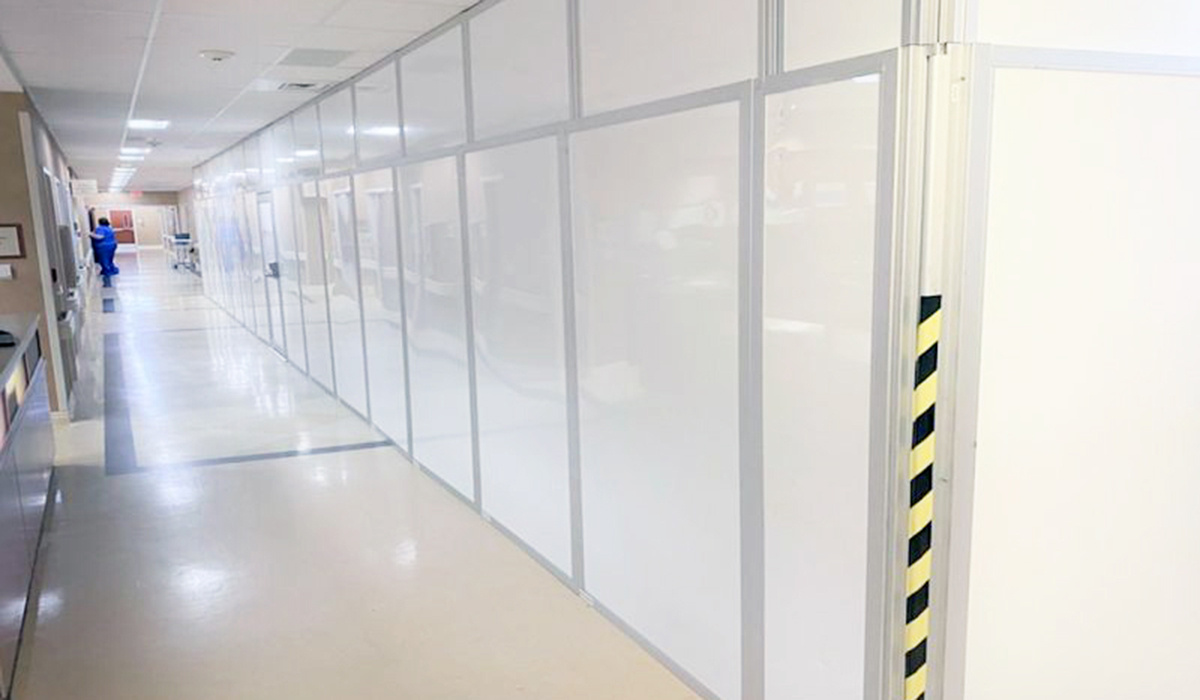
Updated October 8, 2025
Healthcare renovations are unlike any other construction projects. Even small upgrades introduce dust, debris, and airborne contaminants that can threaten vulnerable patients. That’s why every renovation inside a healthcare facility must follow a detailed Infection Control Risk Assessment (ICRA) process—and why choosing the right ICRA-compliant barriers is essential for patient safety and compliance.
Understanding the ICRA Framework
The ICRA process ensures construction activities do not compromise infection prevention protocols. It involves assessing project scope, determining risk levels to patient populations, and implementing the appropriate level of containment and control.
Under ASHE ICRA 2.0™, a fifth precaution class has been added, reflecting the growing need for higher levels of protection during complex healthcare renovations.
Precaution Class Overview:
- Class I–III: Minor work with limited dust generation, such as inspections or small maintenance projects.
- Class IV: Major construction where dust or debris is generated; requires full containment, negative air pressure, and HEPA filtration.
- Class V: Highest precaution level, requiring dual barriers, continuous negative air, and dedicated anterooms for entry and exit.
Each project must be classified before work begins, ensuring all infection risks are proactively controlled.
In short: the higher the class, the stronger the containment requirements.
The Role of ICRA Barriers in Infection Prevention
Temporary ICRA barriers serve as the physical defense line between patient care areas and construction zones. They:
- Prevent dust and debris from migrating into occupied spaces
- Support negative air pressure and HEPA filtration
- Reduce noise and vibration disturbances
- Maintain accessibility and workflow for healthcare staff
- Protect patient safety and privacy during active work
Without compliant temporary wall systems, even small renovation tasks can cause major infection risks.
These barriers aren’t just “temporary walls” — they are integral components of a hospital’s infection prevention strategy.
Why Dust Control Matters in Healthcare Renovations
Dust is one of the most significant and underestimated risks during healthcare construction. When renovations take place in or near occupied care areas, even microscopic airborne particles can carry harmful pathogens that threaten vulnerable patients.
Every time a wall is opened, a ceiling tile is lifted, or a floor is cut, contaminants can be released into the air. In hospitals and clinics, that can lead to healthcare-associated infections (HAIs) — events that are preventable with proper containment.
Effective dust control isn’t just a best practice, it’s a patient safety requirement.
Temporary ICRA barriers and negative air pressure systems form the first line of defense, ensuring construction activity remains completely isolated from patient care zones.
When healthcare facilities implement ICRA protocols early in the project planning phase, infection prevention teams can:
- Anticipate dust and debris risks before construction begins
- Ensure HEPA filtration and negative air pressure are maintained
- Protect HVAC systems from contamination
- Reduce the likelihood of costly infection incidents or shutdowns
In short: dust control is infection control—and it begins with properly installed ICRA barriers.

Exclusive Insights: See how your facility measures up – Download
ICRA-Compliant Barriers vs. Drywall or Plastic Sheeting
While drywall and plastic barriers were once common, neither provides the reliability or compliance healthcare projects now demand.
- Drywall is time-consuming, generates waste, and isn’t reusable.
- Plastic sheeting can’t maintain airtight containment or withstand repeated use.
- Reusable modular wall systems, by contrast, deliver durable, clean, and adjustable containment — built specifically for ICRA Class IV and V environments.
The result: safer job sites, faster installs, and lower total project costs.
STARC Walls: Built for ICRA Compliance
Every STARC product is engineered to support healthcare infection prevention requirements:
- RealWall™ – Provides full-height, airtight containment with up to 50% sound attenuation.
- LiteBarrier™ – Lightweight, reconfigurable containment for fast-turnaround projects.
- FireblockWall™ – One-hour fire-rated and ICRA Class V–compliant; ideal for critical environments like ICUs and operating suites.
- StackBarrier™ – Extends containment up to 40 feet high for lobbies, atriums, or lab expansions.
Each system supports healthcare renovation safety in different ways: RealWall and LiteBarrier provide durable, airtight containment for ICRA Class IV projects, while FireblockWall delivers the highest level of protection for Class V environments. StackBarrier extends containment for large public areas such as lobbies or atriums, where maintaining separation—not infection control—is the priority.
Supporting a Culture of Safety and Compliance
ICRA compliance isn’t just about construction barriers — it’s about building a culture of infection prevention. That means early collaboration between contractors, facility staff, and infection preventionists to plan safe workflows and ensure proper installation and maintenance throughout every phase.
When combined with STARC’s modular wall systems, this proactive approach helps:
- Maintain continuous negative air pressure
- Ensure clean air exchange and filtration
- Keep critical departments open during renovations
It’s the partnership between people, process, and product that makes ICRA compliance effective.
Conclusion
Patient safety is always the top priority in healthcare construction. With ICRA-compliant barriers and proactive infection prevention planning, renovations can happen without compromising care.
STARC’s modular wall systems make it possible — protecting patients, staff, and reputations through every phase of renovation.
Ready to ensure your next healthcare renovation meets ICRA 2.0™ standards? Explore Healthcare Solutions
